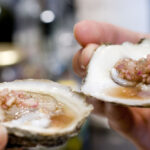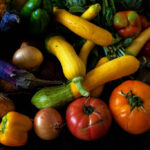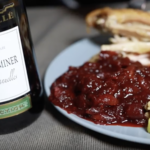
Every region of Spain stakes its own claim to the centuries old invention of tapas. There are as many legends about tapas’ origins as there are styles on a tapas plate: Did King Ferdinand II of Aragon make it mandatory for bar owners to serve food with alcohol in order to calm a drunk and disorderly working class? Did Castilian King Alfonso X, who was prescribed huge quantities of alcohol for medicinal reasons, subsequently conclude that if he was constantly eating to stave off perpetual drunkenness, then so should all his subjects?
The word tapas comes from the verb tapear, which means literally, “to cover.” More likely than legend, it’s said that Andalusian bar patrons once covered their wine glasses with slices of bread, ham, or cheese to keep out fruit flies and dust during the hot southern summers. It’s possible tapas took root after another Spanish King ate the bread even though he knew it was just a lid against the elements, asking for a tapa everywhere he went and encouraging his court to follow suit. Or maybe poverty and food scarcity during the Civil War in the 1930s forced Spaniards to acclimate to smaller portions and inspired bars to give out free snacks to entice more customers during hard times.
We may never know which of the legends are true, but tapas today are a gastronomic staple throughout Spain and Catalonia.

In the US, we’re more accustomed to tapas as a size distinction, if not a national one. We’ve come to understand tapas as small plates, or as shared dishes that pile up between friends. In much of Spain, you’ll probably order a selection of tapas to share from a restaurant menu in much the same way you would in New York or Los Angeles. But in Granada, tapas are done differently.
As a southern city in Spain’s Andalusian region, tapas bars in Granada serve a free tapa with each drink you order. That means a glass of wine, una caña (a small beer), or even un refresco (a soda) comes to your table with a tapa on the side. We’re not talking chips or bar nuts either, these are real Spanish tapas. You might start with a sandwich-style pintxo (open faced and held together with a toothpick) or a montadito (more like a small roll stuffed with toppings), and make your way through tortilla de patatas (a Spanish potato omelette) and cured meats and cheeses, from fried sardines and brined anchovies to housemade meatballs or juicy roasted pork that melts from the bone.
Ordering a glass of wine – a Spanish Rioja, maybe, or a more local wine from the D.O. Granada wine region that sits between the Mediterranean sea and the Sierra Nevada mountains – and eating tapas as an afterthought flips the entire experience of a meal on its head. It’s not that the tapas are afterthoughts in terms of quality, they’re often delicious and hearty and perfectly paired to the wines on offer. Yes, sometimes tapas are simpler and function more as snacks, but all the same. Ordering something to drink instead of building a tapas dinner from a menu puts the focus of a Granadino meal on what food is all about in Spain: joy.
 You still end up with a mouth full of delicious flavors, local spices, and centuries of Spanish culinary history. But instead of counting dishes and making decisions, planning ahead and wondering if you’ve ordered enough, you’ll be lost in conversation. Swilling wines and tasting for terrain and daydreaming. Clinking glasses of beer and telling jokes with neighbors and new friends. You’ll be eating like a Spaniard, losing track of the hours that pass and giving into the pleasures that only unfold when you’re breaking bread with good company.
You still end up with a mouth full of delicious flavors, local spices, and centuries of Spanish culinary history. But instead of counting dishes and making decisions, planning ahead and wondering if you’ve ordered enough, you’ll be lost in conversation. Swilling wines and tasting for terrain and daydreaming. Clinking glasses of beer and telling jokes with neighbors and new friends. You’ll be eating like a Spaniard, losing track of the hours that pass and giving into the pleasures that only unfold when you’re breaking bread with good company.
I spent about a month in Granada’s Barrio Realejo, the city’s old Jewish quarter that cushions the peaceful hills of the Alhambra and the Generalife from the bustling city center and shopping district. It’s no secret that some of the best tapas in Granada can be found in the Realejo, trained by the traditions of the Spanish south, flavored by ancient Moorish and contemporary North African influences, and so often accompanied by the music and the passion that mark a region bound to the history of flamenco. These are a few of my favorite spots to experience the Realejo’s many layers of culture and history over a glass of something, and of course, a tapa to warm your belly.
This tiny locals’ spot offers a relaxing hideaway in the afternoons and a vibrant evening scene as the sun sets. You’ll meet regulars from the surrounding Realejo, students studying at nearby universities and the architectural school around the corner, and tourists stumbling in after long walks at the Alhambra. Candela just celebrated its 20th anniversary last year, and the bar is decorated with two decades of history: famous flamenco posters, photos, art, and mementos that all carry stories the bartenders will spill if you stay long enough. Candela’s tapas are modest and simple, think pintxo-style toasts with toppings like crab salad and perfectly melty layers of local cheese with local olives on the side, but you’re really here for the people-watching, the chat, and on the right nights, live flamenco bands.

My favorite part of Terra is its covered terrace. Sure the room is designed to keep smokers warm (and away from the main dining room) in the winter, but even though I don’t smoke I found the space charming all the same. Look out over some of the Realejo’s famous winding streets, hide from the rain, or just warm up under the heat lamps with a coffee or a caña. Terra makes it easy for plant-based eaters to enjoy their tapas with vegetarian and vegan options that they offer readily, and regular menus del dia, or menus of the day, make it easy to enjoy fresh and filling meals if you’re looking for something heartier than tapa fare. Enjoy the fresh air, peruse the multilingual book pages that decorate Terra’s walls, and stop by their makeshift lending library at the bar. After tapas, dig into some churros y chocolate for dessert.
Nestled in the tapas-happy public square called Campo del Príncipe at the heart of the Realejo, Taberna Tofe specializes in classic Andalusian tapas. Drink a local wine from Granada and make your way down the list of tapas on the rotating menu you’ll find posted both inside and outside. Some of my favorites were traditional dishes like migas, a mountain of fried breadcrumbs burying slices of vegetables and sausage, and the lomo de cerdo, fatty pork loin sizzling with super salty roasted potatoes and perfectly browned onions. Lots of space heaters make the outdoor space cozy even in the winter, and if you find it’s too packed Taberna Tofe sits on a row of traditional tapas bars in the Campo del Príncipe so take a walk along the calle and see which one calls to you.
 Chloe Olewitz is a freelance writer covering culture, lifestyle, and the arts. Her writing has been featured in Playboy, Brooklyn Magazine, i-D, Taste Talks, and Roads & Kingdoms. Learn more about Chloe at www.chloeolewitz.com.
Chloe Olewitz is a freelance writer covering culture, lifestyle, and the arts. Her writing has been featured in Playboy, Brooklyn Magazine, i-D, Taste Talks, and Roads & Kingdoms. Learn more about Chloe at www.chloeolewitz.com.



